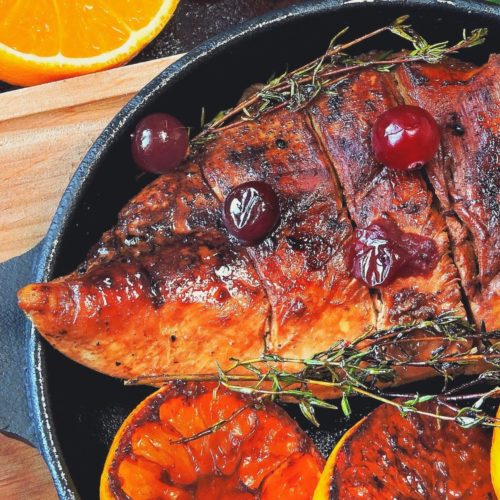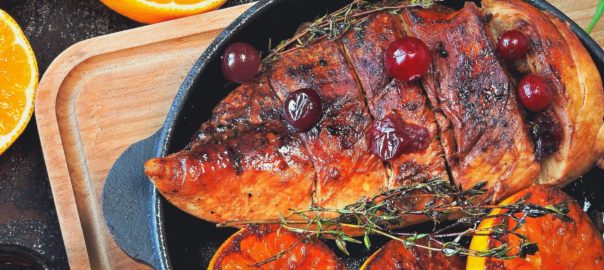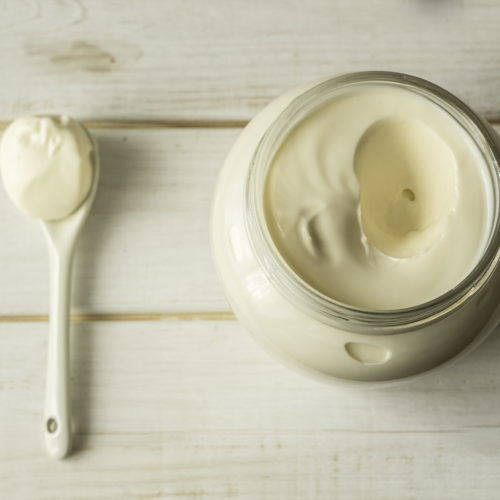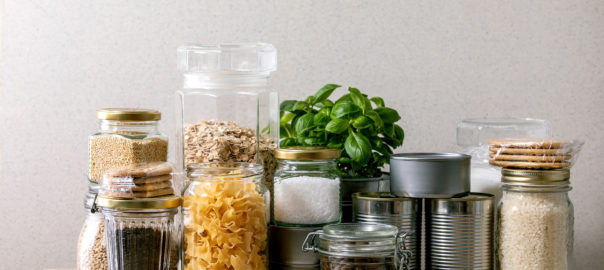Heading into the holiday season, this sweet and savory chicken deserves a spot on your dining table. The bone-in chicken keeps the chicken juicy and brings the flavorful tang from cranberries and zig from orange.
This bright-tasting healthy dish can be easily made ahead of time to heat up before your wonderful holiday dinner.
As a nutrition professional, I encourage you to use fresh or frozen cranberries and fresh-squeezed orange juice instead of the canned options, as they may contain nasty ingredients such as:
- High fructose corn syrup: Scientists believe that excess fructose consumption may be a key driver of many of today’s most serious diseases. These include obesity, type II diabetes, heart disease, and even cancer.
- Artificial color: Red 40 is a synthetic color additive or food dye made from petroleum. Studies have found artificial colors to be harmful to health, especially for those with attention-related disorders.
- Citric acid: This is not what’s naturally found in citrus fruits; it’s too expensive to produce. And there have been reports of sickness and allergic reactions to the manufactured citric acid.
- Pectin or gelatin: Cranberries have a high pectin content, making the added gelatin unnecessary. Also, vegans should avoid this as gelatin is derived from the skin, bones, and connective tissues of animals or fish.

Orange-Cranberry Bone-In Chicken Breasts
Ingredients
- 2 T. olive oil
- 2 lbs. bone-in chicken breasts, with skin
- 1½ tsp fresh sage, chopped
- 1½ t. fresh thyme leaves
- Sea salt and black pepper, to taste
- 1 cup fresh (or frozen) cranberries
- ¼ cup freshly squeezed orange juice
- ¼ cup honey, preferably local
- ½ tsp ground cinnamon
- ½ tsp ground ginger
- ¼ tsp ground cloves
- ⅛ tsp ground nutmeg
Instructions
- Place the top oven rack in the center position and preheat the oven to 400°F.
- Season the chicken with sage and thyme; salt and black pepper, to taste.
- Add olive oil to an ovenproof skillet over medium heat. Place seasoned chicken skin-side down and cook for approximately 4-5 minutes until it releases easily from the bottom of the pan. Turn the chicken and continue cooking for another 4-5 minutes on the remaining side.
- While the chicken is browning, add the cranberries, orange juice, honey, cinnamon, ginger, cloves, and nutmeg to a small saucepan. Set to medium heat and bring to a gentle boil. Cook approximately 4-5 minutes or until the cranberries pop open and the sauce thickens slightly.
- Pour one half of the orange-cranberry sauce over the browned chicken and transfer the skillet into the preheated oven. Roast until the chicken is fully cooked through and the sauce is bubbly for 25-30 minutes or until chicken is cooked through and reaches an internal temperature of 160°F.
- Remove pan from oven and transfer chicken to a serving platter. Cover loosely and let rest for 5 minutes before serving. Top with remaining orange-cranberry sauce (or serve on the side) and serve with your choice of sides.
Start Your Healthy Holiday Plan!
For more healthy holiday/leftover recipes, be sure to get your copy of my Healthy Holiday Recipes and Holiday Leftover Plan ebooks!
Have a wonderful holiday season!







